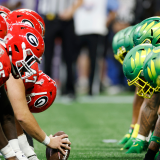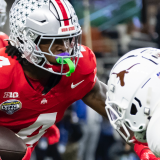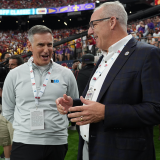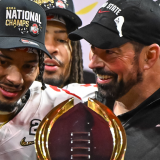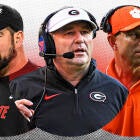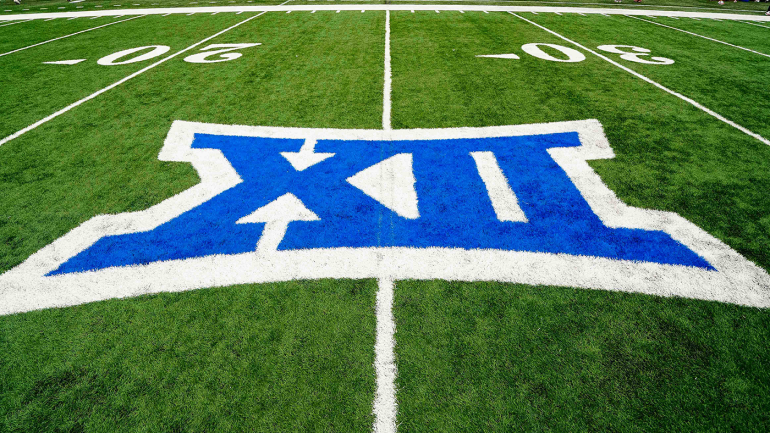
Conference realignment has become an increasingly frustrating attempt to squeeze dollars out of a system that has consolidated resources at the top. The best brands and most of the money are among those 32 teams in the Big Ten and SEC -- and the networks that own their major television rights (ESPN and Fox).
Everything else has become a scramble to the point that one source within the Big 12 said a worst-case scenario would be nothing happening in the league. That would mean staying at 12 teams with BYU, Cincinnati, Houston and UCF In the fold after Texas and Oklahoma leave before the 2025 season.
Some Big 12 athletic directors are worried that the conference's media rights dollars won't stretch far enough to add more programs without their payouts being diminished. Outgoing commissioner Bob Bowlsby testified last summer that Texas and Oklahoma brought 50% of the rights value to the league.
The same reality is emerging for the Pac-12. Even with Oregon and Washington -- the two best brand names remaining among the 22 schools still in the Pac-12 and Big 12 -- there is not much on which the conference can capitalize.
Do the math. There seems to be a consensus forming among key parties that the Big 12 and Pac-12 would be worth more together, in some form, than they are separately.
"Let's say the blood-letting stops at SC and UCLA. Right there, you can't get an increase in rights fees because you lose the [L.A.] market," said Bobby Hacker a West Coast attorney and sports media consultant who spent 18 years as vice president of business and legal affairs for Fox Sports.
Hacker continued: "Now you have the Pac-12, which had less of valued rights deal than any Power Five group. They've now lost the L.A. market. There are no teams here with which to replace it. And if you say, 'We're going to get San Diego State,' there is push back in the conference because a San Diego State or Fresno State don't have the academic cache that the schools had.
"If Oregon and Washington go, Katy bar the door. The option to my mind's eye is Big 12 merger."
A stand-down mentality appears to have emerged … for now.
The Pac-12 is in exclusive negotiations with Fox and ESPN. The Big 12 continues to study expansion. New Big 12 commissioner Brett Yormark made that official with his "open for business" comment at his conference's media days last week.
The Big 12 wants to be hipper, younger, cooler. There's not much that's hip, young and cool about an Iowa State-Cincinnati game.
Conference realignment news & notes
SEC presidents aren't keen to move beyond 16 teams at this moment. That suggests any decision Notre Dame makes about the Big Ten is going to be isolated and will not necessarily impact the SEC.
That focuses attention back on Oregon and Washington, the two biggest "available" pieces. The reason they're not already atop the Big 12 list is because they believe they have options centered around the Big Ten. One problem? Multiple sources tell CBS Sports neither the Ducks nor Huskies nor the pair bring enough value to the Big Ten (in the $80 million to $100 million range per year).
Even if the Big Ten is not open for business, why would Oregon or Washington sign a grant of rights with the Pac-12 knowing the conference is vulnerable? That's how the Pac-12 got in this predicament: Former commissioner Larry Scott signed a 12-year deal in 2012 that appeared lucrative at the time but locked the conference into below-market valuation.
Some have suggested, wherever the schools end up, they be allowed an "out" in the grant of rights contract should an eventual offer come from the Big Ten. But why would any conference knowingly devalue the main source of its revenue?
Regarding the Pac-12, ESPN and/or Fox don't necessarily want to overspend on a property they've already decided is far less valuable than the Big Ten and SEC. It's also no sure thing ESPN gets any of the Big Ten's secondary rights. If they don't have the Big Ten, perhaps that opens their pockets for College Football Playoff expansion, the next major college rights deal on the docket (after the Pac-12 and Big 12).
"I've sort of refocused my thinking. I think we're no longer really talking about college sports through the lens of the NCAA, the Power Five," Hacker said. "College sports is now completely controlled by ESPN and Fox."
"It's definitely not ironclad." That's what Kansas City sports attorney Mit Winter had this stay about the ACC's grant of rights as it relates to the ongoing angst about that conference's schools soon being $50 million annually behind the Big Ten and SEC. He continued: "It would be costly to litigate it and try to get out of it with an uncertain result. I don't think anyone actually wants to get involved in that fight. If they were to get out, they would just agree to some sort of monetary settlement, which would be a huge number."
That figure has been estimated as anywhere from $100 million to $500 million. Clemson, Florida State, Miami, North Carolina and Virginia are the programs mentioned most often as candidates for other conferences.
"There is definitely no sure-fire loophole in the grant of rights," Winter added.
The ACC borrowed heavily from the Big 12 in shaping its grants of rights, sources tell CBS Sports. That agreement is holding Texas and Oklahoma in the league through the 2024 season. Winter said he had input in drafting that Big 12 document. Here's a PDF of the original Big 12 grant of rights signed in 2012. Notice in the "agreement to membership" where the members "agree" to stay together for 99 years.
However, that is different than the actual grant of rights, which states any school leaving the conference must pay the final two years' worth of revenue distribution. In this case, Texas and Oklahoma would both owe approximately $90 million to leave early for the SEC. Now you're getting an idea of why, to date, both schools have committed to the Big 12 through the term of their agreement.
If you want to be a conspiracy theorist, consider the possibility that this round of realignment could lead to one less major conference, which potentially means one less guaranteed spot in an expanded playoff. The original 12-team playoff expansion proposal, rejected in January, included spots for the top six conference champions. A merger of two powers or collapse of one creates greater opportunities for at-large spots for the Big Ten and SEC.
That was the underplayed angle when the Big 12 rebuilt itself last year, whether it would remain in the Power Five after being reconstituted with Group of Five schools. That might be answered in real time. Should the Pac-12 be absorbed by the Big 12 in some form, that would help strengthen the case of it being a Power Four league.
With only four major conferences, would there be a temptation to distribute uneven playoff shares to leagues below the Big Ten and SEC? Currently, the Power Five conferences are contracted to receive the same money -- about $57 million each -- through the 12 years of the CFP deal that expires after the 2025 season. The 65 Group of Five teams split $83 million.
Another example of that widening gap: With the addition of USC and UCLA, the projected annual worth of the Big Ten deal now goes up to about $1.2 billion per year. That means the current Pac-12 rights would have to increase almost 2.5 times ($600 million per year) to reach half of what the Big Ten will be earning. In its latest rights deals, the total MLB contract went up 19%. The NFL increased its rights 63%. The Pac-12 would have to balloon its rights 240% to get to half of the Big Ten.
"They're not going to get there," one executive said of the Pac-12.
That kind of delta between leagues impacts ability to hire the best coaches, academic counselors, mental health experts (Ohio State, for example, has a sports psychologist for each of its 36 sports), nutritionists and strength coaches. For starters.
![[object Object] Logo](https://sportshub.cbsistatic.com/i/2020/04/22/e9ceb731-8b3f-4c60-98fe-090ab66a2997/screen-shot-2020-04-22-at-11-04-56-am.png)


